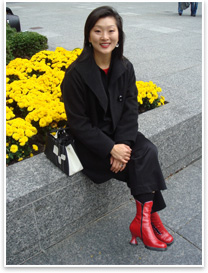
Summary: Grace Kim is the principal and cofounder of Seattle-based Schemata Workshop with husband Mike Mariano, AIA. An active advocate for young professionals, she was the Washington State IDP Coordinator from 2000-2002 and the recipient of the 2004 Emerging Professionals Mentorship Award. Grace also is the author of The Survival Guide to Architectural Internship and Career Development. Education: I went to school at Washington State University for my BArch and the University of Washington for my post-professional MArch. First job: My first real job was working at SOM in Chicago, but I didn’t work in architecture. I was working in their applications support group, which is basically their computer group, doing something that I didn’t think I would ever be doing: teaching architects how to use computer programs.
Favorite book: I guess my favorite book would be The Phantom Tollbooth, by Norton Juster. I first read this story in the third grade. My favorite aunt had given me this book, and I loved the story, but I read it again when I graduated from architecture school and realized what a powerful story it was. It’s the classic story of achieving the unachievable by not realizing that it can’t be done. Last book read: The Whole New Mind by Daniel Pink. The book addresses an important trend towards a high-touch, concept-driven, design-oriented society, but it also vindicated my assertion that architects are storytellers. So much of what we do is listen to the stories of our clients and reinterpret them into physical form. If we can demonstrate to our clients that we understand their story by, in turn, telling them a story about their building and how it achieves their vision and mission, then we can create truly powerful places. So much of what we do is listen to the stories of our clients and reinterpret them into physical form Major professional influence: There were two profound influences. During my first “official” semester in the architecture program, I came into the studio one evening and found a note from my studio instructor suggesting that I consider another major. There was no discussion of this previously and no follow-up to the note. To this day, I don’t know why this note was left for me. I was infuriated by the cowardice of his actions. But, looking back, it probably made me all the more determined to succeed in my academic endeavors. The other inspiring/career changing event was in April 1999 at the conclusion of the first Summit on Architectural Internship. I found myself at the airport bar with John McRae, FAIA, and Cecil Steward, FAIA, two highly regarded academics. Through our conversation, I came to realize that I was the future of the profession. Although there were many capable and inspirational leaders who had attended the summit and were heading our various schools and professional organizations, it was incumbent upon emerging professionals to carry the torch for all those in line behind us. The circular discussions of internship and the woes of interns would not change if those who had learned the tough lessons were overcome with amnesia the moment they become registered professionals. It was then that I realized I needed to be part of the solution for emerging professionals to be empowered to create change in our profession. What’s changing in studio culture: I don’t know how much it’s changing. I know the Institute and ACSA are trying to do a lot to change the culture, but I think it’s going to take a while. It’s very much in the culture of academia to expect a lot from students. Even practitioners still expect pretty unreasonable things. I just taught a three-week studio project at Montana State University, so it was interesting to think about it from that standpoint: of what I was expecting and yet recognizing that the students are still trying to figure out their lives. They have other classes. They have other commitments outside of school. So how does a professor balance that and still expect a lot in terms of performance in the studio? What’s changing in architectural internship: I see more informed interns, meaning interns who are empowered to make decisions about where they’re going to work and about employment in general. Also, they’re being empowered to contribute more in areas of technology, sustainability, and research: areas that the rest of the profession has been a little slow to learn about or respond to. I think the interns have greater understanding of those changes right now. Advice for students entering the profession: Empower yourself by selecting firms that share your values. Remember that you are interviewing firms as much as they are interviewing you. Find the firms where you respect the leaders and that provide mentorship and value your contributions. Be confident, but not arrogant, in asserting your knowledge or expertise in areas such as sustainability and technology—and by technology, I don’t mean be the CAD-monkey, but share your knowledge of GIS, BIM, or multi-media presentations. If your employers are not tech-savvy, show them the tools that are available and how they might be employed to communicate better the story of a project to the client. Be confident, be brave, be respectful. Empower yourself by selecting firms that share your values Best practice tip for colleagues: Consider
staff as a resource in which to invest, much like any other resource
in the office. Value your staff—especially the youngest ones—and
invest in them as your greatest resource. While they need mentorship
and guidance, allow them to mentor you in areas that are outside
your expertise and be open to the fact that they might teach you
a thing or two. You will be younger for it, your practice will be
the richer for it, and the profession will have the possibility to
grow in unimaginable ways. |
||
Copyright 2006 The American Institute of Architects. All rights reserved. Home Page |
||
news headlines
practice
business
design

 Grace H. Kim, AIA
Grace H. Kim, AIA Hobbies:
Hobbies: